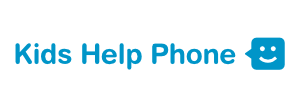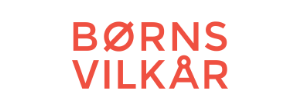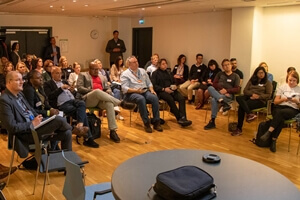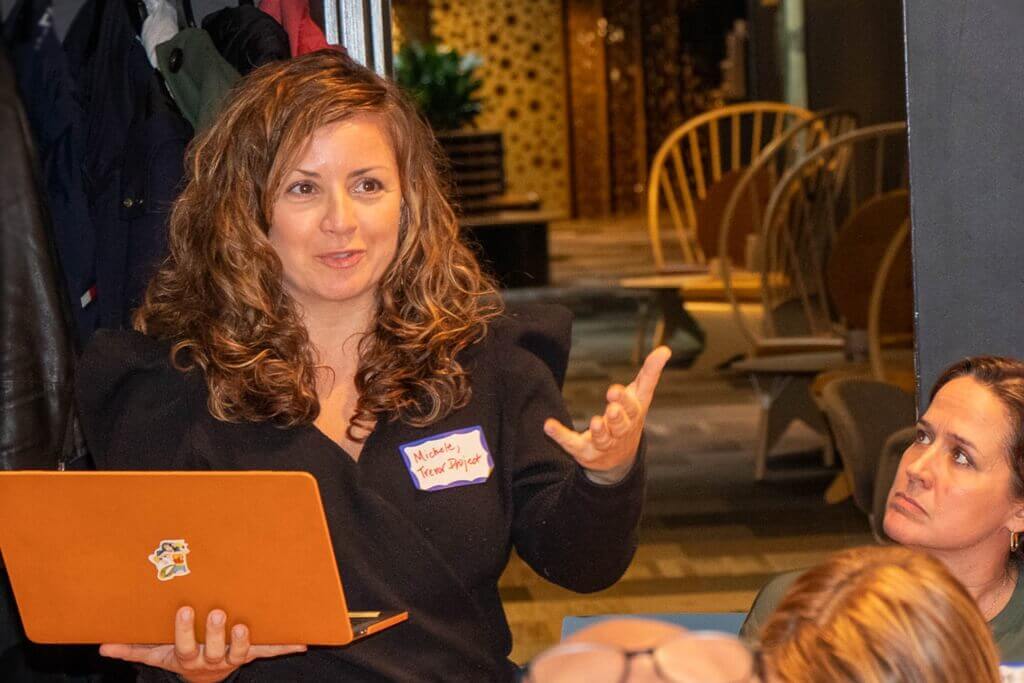


We’re excited to provide a detailed update on a workshop held in Stockholm, Sweden on Monday, September 26, 2022, the day before the opening of the 10th International Consultation of Child Helpline International (CHI). We wanted to explore both innovations already being adopted by child helplines, as well as to hear from the roughly fifty participants what issues they saw affecting innovation and technology for the next five years for the helpline movement. The session was designed for child helplines to talk with their peers about technology under development, technology already in use, as well as pain points that technology might address.
The session was led by Darren Mastropaolo of Kids Help Phone (Canada). The session was co-organized by Darren, Charlotte Smerup and Ali Abbasi of Børns Vilkår (Denmark), and me, Jim Fruchterman of Tech Matters. Andrea Pereira, the Head of Data and Research for CHI, was our key liaison with the CHI member community. I also want to thank the Tech Matters team, who leant their meeting room for the workshop, and benefited greatly from being able to hear directly from so many helplines.
The agenda for the workshop had three segments:
- Helpline innovations from three child helplines
- Emerging trends discussion
- Common helpline challenges going forward
Helpline Innovations
Kids Help Phone (KHP), Canada. Darren explained the stepped care ecosystem of services available from Kids Help Phone to children and youth in Canada. The ecosystem includes services at varying levels of intensity with the option to choose the right service based on needs. At the most basic/inexpensive level, there is educational content for young people to read and view. There are six more steps in their services, offering options such as interactive skill building, moderated peer support, 1:1 volunteer support, and professional counseling. Not surprisingly, professional counseling represents the majority of KHP’s services budget, but serves a smaller % of their users. The stepped care model is effective in shifting resources to lower intensity services and in ensuring users don’t become dependent on intensive services over time by allowing the users of their technology to choose what services they need. Darren highlighted how they have chosen to deploy artificial intelligence tools (AI), which is primarily via a chatbot to help their users navigate these services on the website. He concluded the presentation by sharing their technology design and infrastructure in some detail, a resource that should be useful for any helpline tackling a digital transformation project in the future.

Børns Vilkår (BV), Denmark. Charlotte and Ali presented a different way of using AI. Børns Vilkår made a philosophical decision to not have AI tools interacting directly with young people. They developed an AI “Counselor Guide” to assist volunteer counselors. BV had an existing knowledge-base available to their counselors, but in practice it wasn’t easy for volunteers to search while on a text conversation with a child. Their “Counselor Guide” system listens to the text messages being sent by the child, and tries to identify the key topics being discussed (e.g., depression, bullying, impending divorce of the child’s parents, and so on). Based on that, it presents some short and useful advice about these topics, alongside the text conversation, to assist the volunteer in doing a better job of counseling. The Counselor Guide gets some of the topics right in the majority of conversations, and the BV volunteer counselors like the support it provides.
A second AI-driven tool was a data scrubber, which takes personally identifiable information (name, address, phone number), out of chat logs. This is important for BV to both have chat data for training AI tools, while also meeting their obligations under European privacy laws (GDPR). This type of tool is likely to be replicated in many more countries as helplines try to take advantage of AI tools to support their program goals of serving children.
C-Sema, Tanzania. Michael Marwa, the head of the child helpline in Tanzania, presented their experience with the AinoAid chatbot, which was developed by We Encourage, a Finnish tech company, in collaboration with supporters including Felm, a Finnish faith-based charity. Working together, they deployed a Swahili-capable chatbot trained on questions from callers in Tanzania and answers from counselors. The goal is to offer psychosocial support, information, and referrals via the chatbot, while retaining the ability to get help from one of the helpline’s human counselors. C-Sema takes up to two million calls per year, and is hopeful the chatbot will add to their capacity to respond to this level of demand for their services.

Emerging Trends Discussion
The workshop then opened up to the attendees in the room to tap their knowledge and ideas. And they had a lot to say about how they had integrated innovation into their work as well as challenges and ideas from other fields! The following bullet points can only partially capture this dynamic conversation:
- Data is essential to the work of helplines, and to improving programs for children, and right now helplines are not yet getting the value from data they could be.
- Many helplines suffer from having a hodgepodge of different tech tools and would benefit from a unified system.
- There are tradeoffs between using adaptations of mainstream call-center technology versus implementing systems specifically designed for helplines, including custom-built tools.
- Getting user feedback on the services for improvement is very beneficial. Some helplines are using post-conversation surveys, and/or doing focus testing with youth advisors.
- Helplines need better supervisor tools for helping counselors and doing quality control after the fact.
- Could technology play a role in providing mental health/wellness support for the counselors on the front lines or for identifying counselors that might need support?
- The real languages used in helpline conversations pose a difficult problem for mainstream AI tools that may limit their usefulness in the short term. Two specific issues were highlighted: (1) AI tools are not trained on the languages spoken or texted in almost all countries (including slang and local expressions); (2) children and young people don’t text the same way adults do.
- The need to have a tech expert on the staff of the helpline to represent the helpline’s interests, rather than depending wholly on consultants and vendors with their own priorities and interests.
- The need to spot trends and not fall behind was a significant concern.
- Gaming and the metaverse both came up, with gaming having already reached mass scale among young people, and the possibility of metaverse technology reaching similar scale.
- There was a concern that helplines were not present where young people are.
- Discord is an example of a text channel not yet supported by all (or almost all) of child helplines.
- The need for technology to facilitate cross-border sharing came up frequently, with several examples already in progress:
- the Palestinian helpline (SAWA) assisting the Greek helpline (Smile of the Child) with Arabic speaking young people,
- the Canadian helpline (KHP) supporting the Irish helpline late at night, and
- the Israeli helpline (ERAN) staffing with Hebrew-speaking volunteers from North America also for late night.
- The arrival of for-profit mental health companies into the space, especially after Covid, was discussed, but didn’t seem to concern most of the helplines encountering them.
Future Challenges: Small Groups
Based on the open conversation, some major themes came up and five small groups came together. Although technology and innovation might be able to help with some of these themes, it was clear that there were some overarching issues. The groups often identified specific innovations they would like to see developed or shared more widely.

Fundraising
Lack of adequate funds was a common issue. There was a perception that most donors don’t want to fund core costs, including funds for innovation and improvements. The group discussed making a bigger and common case for core support and innovation funding for helplines.
Unmet need / long wait times
A related issue was the mismatch between the levels of need, and the resources available to respond to that need, which leads to long wait times for being connected to a human counselor. The tech aspects of this included:
- better workforce management tools and demand forecasting,
- entertainment, bots, and games to offer value instead of, or while waiting in queue for, human counselors, and
- cross-time-zone partnerships to have human counselors available after midnight.
Frequent / repeat / chronic users
The issue of repeat callers came up in two main ways. The positive way was a repeat caller as an indication of user satisfaction: if they call back a second time it is an indication that they found value in the first call. However, the bulk of this conversation focused on a problem experienced by many helplines, which is the repeat caller/texter misusing the helpline to the point where other callers are not able to receive services. Some helplines said that up to a quarter of their capacity was being absorbed a very small number of repeat callers, some with complex needs, and others who seem dedicated to abusing the helpline services. This area is particularly challenging for helplines promising anonymity to callers, especially when they have decided to not use telephone numbers or similar identifiers as a matter of policy.
The discussion of solutions to these challenges included ways to create boundaries, routing repeat callers to specialized counsellors, and using technology to identify frequent callers (even for anonymous helplines).
Support for frontline staff / burnout
Helpline leaders were quite concerned about the wellbeing of their staff and volunteer counselors. The issues of burnout and turnover were top of mind. Innovations discussed included:
- setting up monitoring frameworks to detect burnout,
- explicit tools for self-care support (i.e., reminders to take a break),
- improved training on how to manage these challenges for the counselors.
Reaching vulnerable populations
Helplines are very aware that not all child and young people have equitable access to helpline services. Helplines identified a range of issues that impact these vulnerable populations and some areas of opportunities for helplines to reach them:
- Stigma
- Lack of cultural competency
- Insufficient outreach to these communities
- Lack of support for kids on the move
- Adjusting tone and messaging to better reach males (most helplines have predominately female users)
- Mobile counselling for rural areas
Conclusion
This workshop format complemented the more formal structure of the International Consultation, and provided an open-ended forum for discussion of important issues. Of course, many of the issues that came up in the workshop were also discussed in plenary and major sessions later in the week. There is also going to be an effort to have more CHI members engage in working groups on topics like these. In addition, Darren Mastropaolo delivered a presentation to the larger audience later in the week, summarizing the workshop. The workshop provided a rare opportunity for the community to come together and go deep on important issues faced by child helplines, and how technology might help them respond.
Supporting Resources
Here are the supporting documents and presentations from the workshop:

0 Comments